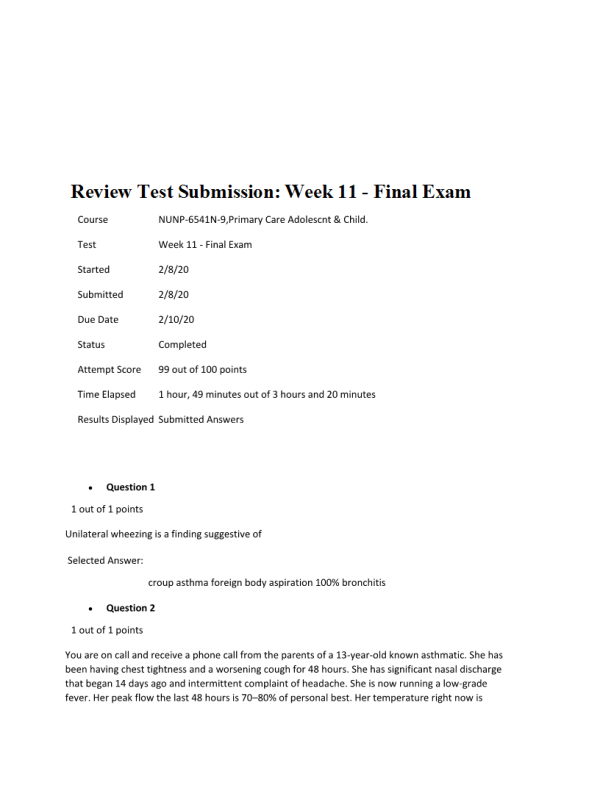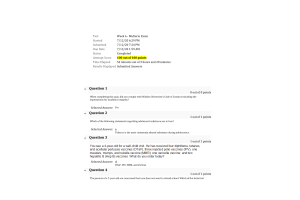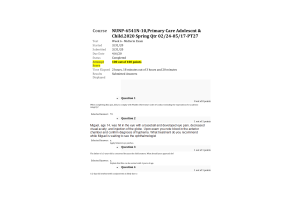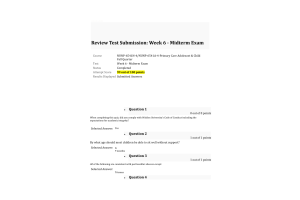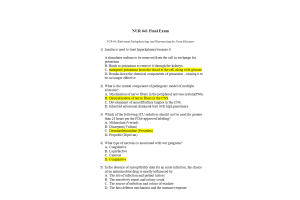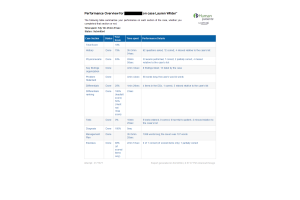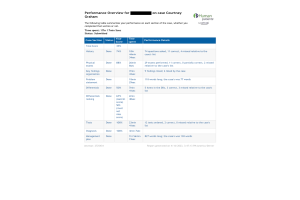NURS 6541 Week 11 Final Exam99 out of 100 Points
- $49.00
2. Question: You are on call and receive a phone call from the parents of a 13-year-old known asthmatic. She has been having chest tightness and a worsening cough for 48 hours. She has significant nasal discharge that began 14 days ago and intermittent complaint of headache. She is now running a low-grade fever. Her peak flow the last 48 hours is 70–80% of personal best. Her temperature right now is 101.7°F. She is on salmeterol with corticosteroid (Advair) and PRN albuterol. Which of the following is most appropriate?
3. Question: You see a patient you believe has folliculitis. What medication would be the best to treat this patient? The patient has no allergies.
4. Question: The most common cause of primary amenorrhea is
5. Question: Kelly, your 11-year-old well visit patient, presents to the office with weight loss, polyuria, and polydipsia. Which of the following do you need to rule out?
6. Question: Children in child care facilities are at greater risk of being exposed to which of the following infections?
7. Question: A 6-year-old boy is left alone for 10 hours, now with hematemesis and pneumomediastinum on chest x-ray. Which of the following is the most likely etiology?
8. Question: A 14-month-old child has lower extremity bowing, a waddling gait, genu varum, and is at the 5th percentile for height. Laboratory data include low-normal serum calcium, moderately low serum phosphate, and elevated serum alkaline phosphatase levels, hyperphosphaturia, and normal parathyroid levels. Which of the following is the most likely diagnosis?
9. Question: The most common trigger for an acute asthma episode in the very young child is
10. Question: What is the primary treatment for testicular torsion?
11. Question: When Jason, age 12, slid into homeplate while playing baseball, he injured his ankle. You are trying to differentiate between a strain and a sprain. You know that a sprain
12. Question: The most common presentation of Hirschprung disease is which of the following?
13. Question: Jennifer, age 16, is an active cheerleader who just developed type 1 diabetes. She is worried that she will not fit in with her friends anymore because she does not think she can have all the same snacks they have. How do you respond?
14. Question: Which of the following is not a sign or symptom of congenital hypothyroidism?
15. Question: You see a 7-year-old boy a day after he was bitten by his pet dog. According to the mother, the dog bit the child after he snuck up on the dog and grabbed his tail. The dog has had all its vaccinations, including rabies. The child has had no fever, has full movement of the injured limb, and has no sign of neurologic or vascular injury. The wound is on the child’s forearm, is not deep, and is not bleeding, but has developed about 2 cm of erythema surrounding the site. Which of the following is the most appropriate treatment?
16. Question: Robert, your 15-year-old male patient, is here today for a well visit. He is tall in stature and has increased arm span, laxity of joints, pectus excavatum, and an abnormal echocardiogram. Which of the following diagnosis would you suspect Robert as having?
17. Question: An adolescent female presents with a 2-day history of increasing lower abdominal pain. She has mild vomiting and anorexia and fevers to 101F. She is unable to defecate but has an urge to do so. CBC reveals a slightly elevated WBC of 14,000, but is otherwise normal. Serum electrolytes are normal. The next step is
18. Question: Vomiting in infancy has a long list of differential diagnoses. Which of the following other symptoms would mostly likely point to pyloric stenosis?
19. Question: Which of the following is a characteristic physical sign of fragile X syndrome in adolescent males?
20. Question: A 3-week old presents to the office in January with a 1-week history of nasal congestion and occasional cough. On the night prior to the visit in infant developed a fever 102ºF rectally, was difficult to breastfeed, and had paroxysmal coughing and noisy, labored breathing. On exam, you note an ill-appearing infant who is lethergic with wheezing, tachypnea, and intercostal retractions. The infant is home with the mom at this time; however, has a sibling who is 4-years-old and is in daycare and recently had cold symptoms. If the patient has been diagnosed with RSV bronchiolitis, which of the following would be the treatment of choice
21. Question: An adolescent who has tall stature, increased arm span, laxity of joints, pectus excavatum, and abnormal echocardiogram would be expected to have
22. Question: An 18-month-old African American girl is brought to your office because she has been crying and stopped walking today. She will crawl, however. Her mom denies any injury to the child. On examination, she is crying but consolable in her mother’s arms. She has bruising and swelling just proximal to the left ankle. An x-ray
reveals a spiral fracture of the tibia. At this time, you advise the mother that:
23.Question: A small-for-gestational-age, dysmorphic newborn infant has microcephaly and sloping forehead, cutis aplasia (missing portion of the skin and hair) of the scalp, polydactyly, microphthalmia, and omphalocele. Which of these is the most likely diagnosis?
24. Question: A 16-year-old presents with pharyngitis, cough, and high fever. Her chest x-ray reveals bilateral pulmonary infiltrates. Her white blood cell count is normal and the neutrophil count is normal. The most likely etiology is
25. Question: A common cause of in-toeing in childhood is
26. Question: Individuals with chronic adrenal insufficiency often have
27. Question: Which of the following should be done annually after 1 year of age in a child with Down syndrome?
28. Question: Sarah, age 13, is markedly obese and has a poor self-image. How do you differentiate between compulsive eating and bulemia?
29. Question: The peak incidence of osteosarcoma is
30. Question: A 10-year-old boy jumps off a 2-foot wall, twisting his foot and ankle upon landing. His ankle x-ray reveals a fracture of the distal tibia over the articular surface into the epiphysis and physis. Based on the Salter-Harris classification for growth plate injuries, you know this as a
31. Question: One of the most appropriate agents used to treat influenza A
32. Question: An essential test in the evaluation of a 2-year-old being managed for Kawasaki disease is
33. Question: You have a patient with pityriasis rosea. You will recommend all of these treatments, except
34. Question: A 14-year-old girl from another state was followed for 7 years for a history of insulin-dependent diabetes mellitus. Her hemoglobin A1C is 14.9%. This laboratory test indicates which of the following?
35. Question: A 7-month-old female was brought by her mother to an outpatient clinical because of a 2-day history of fever, copious nasal secretions, and wheezing. The mother volunteered that the baby has been healthy and has not had these symptoms in the past. The infant’s temperature is noted to be 100.7°F, her respiratory rate is 50 breaths/min, and her pulse oximetry is 95% on room air. Physical examination reveals no signs of dehydration, but wheezing is hear on lung auscultation. The infant shows no
improvement after three treatments with nebulized albuterol. Which of the following is recommended treatment?
36. Question: A child has developed her second perirectal abscess in 6 months. She should be evaluated for which of the following conditions?
37. Question: A 9-month-old has been diagnosed with gastroenteritis. He attends a daycare facility. What is the likely cause of the illness?
38. Question: Hypercholesterolemia in children older than 2 is defined as a total cholesterol at or above
39. Question: A 3-week-old male infant with 2 days of projectile, nonbilious vomiting and constant feeding. Which of the following is the most likely etiology?
40. Question: Which fo the following foods would be most appropriate for a child with celiac disease?
41. Question: The most common cause of UTI (urinary tract infection) in the pediatric population is:
42. Question: Which of the following is not found in an adolescent with untreated Graves' disease?
43. Question: What does shift to the left mean in a white blood count?
44. Question: Prophylactic penicillin should be started in children with sickle cell anemia by
45. Question: Six months after being diagnosed with what appears to be insulin-dependent diabetes, the 5-year-old in the case presentation has a significant decrease in his insulin requirement. Which of the following is the most likely explanation?
46. Question: Tommy has bloody diarrhea. His family eats fast-food four to five times each week. Which organism may have caused the diarrhea?
47. Question: Which chromosomal abnormality is associated with short stature in girls?
48. Question: Maddie, age 2, had a complete blood count (CBC) drawn at her last visit. It indicates that she has a microcytic hypochromic anemia. What should you do now at this visit?
49. Question: A 2-year-old boy is brought in with fever and poor feeding. He started getting sick yesterday and has worsened significantly today. He has had no recent illnesses or injuries, and no known ill contacts. On examination, his temperature is 101°F, he is tachycardic, and he appears ill. He is lying on his back with his left leg flexed and abducted at the hip. The HEENT examination is normal, heart is tachycardic but regular, and the lungs are clear. The abdomen is nontender and has normal bowel sounds. He screams in pain when you move his left leg from its resting position. Blood work reveals an elevated WBC count of 15,000 mm3 and an ERS or 45 mm/h. An x-ray of his left hip shows a widened joint space but no fractures. What is your next step at this point?
50. Question: When a neonate is initially protected against measles, mumps, and rubella because the mother is immune, this is an example of which type of immunity?
51. Question: You are examining Beth, age 9 months, and note a palpable right supraclavicular node. You know that this finding is suspicious for
52. Question: A 4-year-old female with profuse vomiting, sweating, lacrimation, and diarrhea, who seizes in the emergency room. Which of the following is the most likely etiology?
53. Question: A 6-year-old male is brought in for evaluation of a painful hip. He has been limping and not wanting to walk for the past 2 days. He has no obvious injury. He feels a little better if he is given ibuprofen. He has not had a fever and does not have any other current symptoms, although he had "the flu" last week. On examination, his vital signs are normal. His right hip has some pain with internal rotation. He walks with a pronounced limp. Which of the following statements is most accurate?
54. Question: You see a 7-year-old with a positive stool culture for Salmonella enteriditis. The appropriate therapy for a non-dehydrated child
55. Question: A common presenting symptom of inflammatory bowel disease is
56. Question: Which of the following statements is not true with slipped capital femoral epiphysis?
57. Question: A mother brings a 2-year-old to your office with the complaint that she passes 5 to 10 watery stools per day that often contain undigested food. The child appears healthy and has no other GI symptoms. She is acting, eating, and voiding normally. Weight gain is normal and the mother states she often drinks (her favorite drink is Kool-Aid) instead of eating. The best management for this condition is:
58. Question: Which of the following is not a feature of DiGeorge syndrome?
59. Question: Dave, age 17, has gynecomastia. You should also assess him for
60. Question: Mark, age 15, is 5 feet tall andn weighs 85 pounds. You suspect anorexia and know that the best initial approach is to
61. Question: In mild to moderate attacks of acute asthma, Albuterol should be given every 4-6 hours prn and routine medication should be
62. Question: Which of the following is not true of insect stings from bees, wasps, and fire ants?
63. Question: Ben has been diagnosed with folliculitis, an inflammatory condition involving the pilosebaceous follicle. What is the most common cause of this condition?
64. Question: Which of the following therapeutic options is common for the treatment of both bee stings and bite wounds?
65. Question: Pinworms can cause which of the following?
66. Question: The classic radiographic finding of croup is
67. Question: An 8-month-old female infant with bilious vomiting, constant abdominal pain for 12 hours and upper GI study showing beaklike appearance of contrast. Which of the following is the most likely etiology?
68. Question: Mrs. Bay is upset. She is convinced something is seriously wrong with her son. He is a 2-month-old and frequently vomits after feeding. Which of the following is most suggestive of GERD (gastroesophageal reflux disease)?
69. Question: Lyme disease is most closely associated with which of the following skin lesions?
70. Question: The following clinical description best matches which genetic disorder? A 15-year-old girl with primary amenorrhea is noted to be well below the 5th percentile for height. She has hypertension, a low posterior hairline, prominent and low-set ears, and excessive nuchal skin.
71. Question: Jason, age 14, appears with tender discoid breast tissue enlargement (2-3 cm in diameter) beneath the areola. Your next action would be to
72. Question: Your patient has inflammatory bowel disease. Which of the following finding is most consistent with ulcerative colitis?
73. Question: Which of the following is not characteristic of an apparent life-threatening event (ALTE)?
74. Question: Riley, a 12-year-old girl, has scaly, hyperpigmented lesions in a "Christmas tree" distribution. It is predominantly on her trunk. One lesion is on her buttock that is larger than the other, at about 4 cm in diameter. What is your diagnosis?
75. Question: An 8-month-old baby arrives to the office with his mother with a complaint of decreased left arm movement. He is a product of a normal term pregnancy, has had no medical problems, and was in good health when his mother dropped him off at the daycare center. Upper arm radiographs show a left humerus spiral fracture. Which of the following is the most appropriate next step in management?
76. Question: Which of the following physical stigmata are common in newborns with Down syndrome?
77. Question: Which of the following vaccines provides protection against a common type of sepsis/meningitis?
78. Question: Which of the following conditions is most responsible for developmental delays in children?
79. Question: Which of the following objective data are associated with significantly better long-term outcomes in children born with open spina bifida?
80. Question: Jack, age 17, has been complaining of a painful knob below his right knee that has prevented him from actively participating in sports. He has recently been given a diagnosis Osgood-Schlatter disease and asks you about his treatment options. You tell him that the initial treatment is
81. Question: Fifth disease is usually
82. Question: Hope is a 7-month-old who presents in January with a 1-day history of cough, yellow nasal discharge, and low-grade temp (T max 100°F). She was previously healthy. She does have 2+ edema of the nasal turbinates and cloudy rhinorrhea. She is afebrile in the office. Her chest, mouth, and ears are clear. You prescribe:
83. Question: In children who have not received antibiotics in the past month, which antibiotic is recommended by the Centers for Disease Control and Prevention for the management of acute bacterial respiratory infection?
84. Question: Which of the following symptoms are most suggestive of pneumonia in a young child?
85. Question: The most useful test for evaluation of suspected acute rheumatic fever is
86. Question: What does a low level of thyroid stimulating hormone (TSH) indicate?
87. Question: When examining a child with abdominal pain, what symptom would lead to a likely organic etiology?
88. Question: John is 4 years old and in today for a well child visit. He is due for his 4-year-old immunizations. He was recently diagnosed with ALL and is being treated with chemotherapy and radiation. Which statement is true about immunizations during treatments during childhood cancer?
89. Question: Which of the following is important to determine in the recent history of a child with suspected Clostridium difficile infection?
90. Question: A healthy 8-month-old infant presents with diarrhea but no dehydration. What is the best advice to give to the parents?
91. Question: Which of the following is the primary diagnostic tool used in the evaluation of seizure disorders?
92. Question: Screening infants for anemia should occur at what age?
93. Question: Absence seizures
94. Question: Antibiotic therapy is one of the mainstays of treatment for which of the following causes of wheezing?
95. Question: Kawasaki disease is most common in
96. Question: A small-for-gestational-age infant is born to a 35-year-old woman. He has low-set and malformed ears, microcephaly, rocker-bottom feet, inguinal hernias, cleft lip/palate, and micrognathia. Chromosomal analysis is likely to reveal which of the following?
97. Question: 15-day-old infant has respiratory distress. A quick observation suggests she has slight cyanosis, hepatosplenomegaly, and features consistent with Down syndrome. The cardiac examination demonstrates a loud first heart sound, a low-pitched, mid-diastolic murmur at the lower left sternal border, and a harsh apical holosystolic murmur in the mitral area. Which of the following cardiac conditions most likely explains her heart findings?
98. Question: Grace, age 15, has been diagnosed with acne. Which of the following is not true with this condition?
99. Question: A 7-year-old presents with abrupt fever, stridor, drooling, and hyperextension of the neck. You examine the nose and throat and notice one tonsil is enlarged and there is marked erythema of the pharynx with uvular deviation. Which is most appropriate?
100. Question: Which of the following is true regarding the diagnosis of epiglottitis?
101. Question: When completing this quiz, did you comply with Walden University’s Code of Conduct including the expectations for academic integrity?
